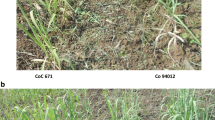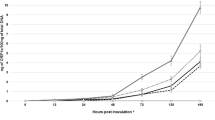Abstract
Colletotrichum falcatum Went causing red rot is a major constraint to cane production and productivity across sugarcane growing countries in Asia. The fungal pathogen exhibits enormous variation under field conditions; the pathogenic variants emerge regularly in tune with deployment of new host varieties for cultivation making the resistant to susceptible referred as ‘varietal breakdown’. Although such phenomena occurred regularly, how the varieties succumb to the C. falcatum pathotypes is not clearly established, and hence, longevity of red rot-resistant varieties become unpredictable under field conditions. The soil-borne inoculum surviving as crop debris is the known source of C. falcatum (Cf) inoculum to cause infection in the field, probably after repeated attempts in a variety which was hitherto resistant. Hence, a detailed study was conducted with a set of Cf pathotypes varying in their virulence and ten varieties with their disease reactions vary from moderately resistant (MR) to highly susceptible (HS) by inoculating the pathogen by the plug method on standing canes and applying Cf inoculum to the soil, under field conditions. The three seasons study clearly indicated that disease reactions in sugarcane varieties to different Cf pathotypes in the plug method did not vary among the seasons, whereas the sugarcane varieties behaved differently for disease development from soil-borne inoculum. When disease development from the two inoculation methods was compared with respect to their known disease reaction, MR and HS varieties showed a similar pattern. However, four of the five moderately susceptible (MS) varieties showed a deviation for higher disease development from soil inoculum to certain pathotypes. Such disease development in the trial from soil inoculum is reflected by a similar behaviour in disease endemic locations, where they succumbed to the pathogen. Overall, the study explains susceptibility of sugarcane varieties for Cf infection from the inoculum surviving in the soil in due course in the field, although their host reactions are MR or MS. Also these findings provide an evidence for varietal breakdown to C. falcatum in sugarcane from soil-borne inoculum under field conditions, for the first time.

Similar content being viewed by others
References
Agnihotri, V.P. 1983. Diseases of Sugarcane, 363. New Delhi: Oxford and IBH Publishing Co.
Barber, C.A. 1901. Sugarcane diseases in Godawari and Ganjam Districts. Madras Department Land Records and Agricultural Bulletin 512(43): 181–194.
Beniwal, M.S., and K.S. Virk. 1989. Pathogenic variability in Colletotrichum falcatum incitant of red rot of sugarcane. Indian Phytopathology 42: 95–98.
Butler, E.J. 1906. Fungal diseases of sugarcane in Bengal. Memoirs of Department of Agriculture, India, Botany Series 1(3): 2–24.
Chona, B.L. 1954. Relative resistance of sugarcane varieties to red rot. Indian Journal of Agricultural Sciences 24: 301–315.
Chona, B.L. 1980. Red rot of sugarcane and sugar industry—A review. Indian Phytopathology 33: 191–207.
Chona, B.L., and T.K. Naraini. 1952. Investigations on the survival of Colletotrichum falcatum in soil. Indian Phytopathology 5: 152–157.
Chona, B.L., and W.G. Padwick. 1942. More light on the red rot of epidemic. Indian Farming 3: 70–73.
Duttamajumder, S.K. 2002. A century of red rot disease of sugarcane in India. In Sugarcane Crop Management, ed. S.B. Singh, G.P. Rao, and S. Eswaramoorthy, 52–108. Houston: SCI TECH Publishing LLC.
Ganesh Kumar, V., R. Viswanathan, P. Malathi, M. Nandakumar, and A.R. Sundar. 2015. Differential induction of 3-deoxyanthocyanidin phytoalexins in relation to Colletotrichum falcatum resistance in sugarcane. Sugar Tech 17: 314–321.
Malathi, P., R. Viswanathan, and R. Jothi. 2006. Specific adaptation of Colletotrichum falcatum pathotypes to sugarcane cultivars. Sugar Tech 8: 54–58.
Mohanraj, D., P. Padmanaban, and R. Viswanathan. 2012. Screening for red rot resistance in sugarcane. In Functional Plant Science and Biotechnology 6 (Special Issue 2), ed. R. Viswanathan and A.R. Sundar, 51–62. Ikenobe: Global Science Books.
Nandakumar, M., P. Malathi, A.R. Sundar, and R. Viswanathan. 2020. Use of green fluorescent protein expressing Colletotrichum falcatum for precise host-pathogen interaction studies in sugarcane. Sugar Tech 22: 112-121 https://doi.org/10.1007/s12355-019-00751-8.
Padmanaban, P., D. Mohanraj, R. Viswanathan, M.M. Rao, N. Prakasam, R. Jothi, and K.C. Alexander. 1996. Differential interaction of sugarcane clones to pathotypes of Colletotrichum falcatum Went. Sugar Cane 4: 16–20.
Rafay, S.A., and V.B. Singh. 1957. A new strain of Glomerella tucumanensis. Current Science 26: 19–20.
Sathyabhama, M., R. Viswanathan, P. Malathi, and A.R. Sundar. 2016. Identification of differentially expressed genes in sugarcane during pathogenesis of Colletotrichum falcatum by suppression subtractive hybridization (SSH). Sugar Tech 18: 176–183.
Sathyabhama, M., R. Viswanathan, M. Nandakumar, P. Malathi, and A.R. Sundar. 2015. Understanding sugarcane defense responses during the initial phase of Colletotrichum falcatum pathogenesis by suppression subtractive hybridization (SSH). Physiological and Molecular Plant Pathology 91: 131–140.
Singh, N., S. Lal, and K. Singh. 1986. Survival of red rot pathogen in sugarcane infected debris. Indian Journal of Sugarcane Technology 3: 125–128.
Singh, K., and R.P. Singh. 1989. Red rot. In Sugarcane Diseases of the World: Major Diseases, ed. C.G. Ricaud, B.T. Egan, A.G. Gillaspie, and C.G. Hughes, 169–188. Amsterdam: Elsevier.
Srinivasan, K.V. 1962. Some observations on variation in the red rot pathogen, Glomerella tucumanensis (Speg.) Arx & Muller. Proceedings of International Society of Sugar Cane Technologists 11: 795–802.
Srinivasan, K.V. 1965. Towards the ideals of red rot resistance—Ends and means. Proceedings of International Society of Sugar Cane Technologists 12: 1108–1117.
Srinivasan, K.V., and N.R. Bhat. 1961. Red rot of sugarcane—Criteria for grading resistance. Journal of Indian Botanical Society 40: 566–577.
Sundara, B. 1998. Sugarcane Cultivation. New Delhi: Vikas Publishing House Pvt Ltd.
Viswanathan, R. 2010. Plant Disease: Red rot of Sugarcane. New Delhi: Anmol Publications Pvt Ltd.
Viswanathan, R. 2012. Molecular basis of red rot resistance in sugarcane. In Functional Plant Science and Biotechnology 6 (Special Issue 2), ed. R. Viswanathan and A.R. Sundar, 40–50. Ikenobe: Global Science Books.
Viswanathan, R. 2013. Screening for diseases: Red rot. Annual Report of Sugarcane Breeding Institute 2012–13, Coimbatore, India.
Viswanathan, R. 2017. Pathogen virulence in sugarcane red rot pathogen versus varieties in cultivation: Classical case of loss in virulence in the pathotype CF06 (Cf671). Sugar Tech 19: 293–299.
Viswanathan, R. 2018. Changing scenario of sugarcane diseases in India since introduction of hybrid cane varieties: path travelled for a century. Journal of Sugarcane Research 8(1): 1–35.
Viswanathan, R., P. Malathi, and P. Padmanaban. 2003. Variation in sugarcane red rot pathogen Colletotrichum falcatum Went. In Frontiers of Fungal Diversity in India, ed. G.P. Rao, C. Manoharachari, D.J. Bhat, R.C. Rajak, and T.N. Lakhanpal, 639–667. Lucknow: International Book Distributing Co.
Viswanathan, R., P. Malathi, A. Ramesh Sundar, S. Aarthi, S.M. Premkumari, and P. Padmanaban. 2005. Differential induction of chitinases and thaumatin-like proteins in sugarcane in response to infection by Colletotrichum falcatum causing red rot disease. Journal of Plant Diseases and Protection 112: 537–542.
Viswanathan, R., P. Malathi, A.R. Sundar, K. Kaverinathan, M.L. Chhabra, B. Parameswari, and R. Jothi. 2017. Diversity of Colletotrichum falcatum population in India: Comparative virulence at two different agro-climatic regions. International Sugar Journal 119: 966–977.
Viswanathan, R., D. Mohanraj, P. Padmanaban, and K.C. Alexander. 1996. Synthesis of phytoalexins in sugarcane in response to infection by Colletotrichum falcatum Went. Acta Phytopathologica et Entomologica Hungarica 31: 229–237.
Viswanathan, R., M. Sathyabhama, P. Malathi, and A.R. Sundar. 2016. Transcriptome analysis of host-pathogen interaction between sugarcane and Colletotrichum falcatum by Suppression Subtractive Hybridization and Illumina sequencing. Proceedings of the International Society of Sugar Cane Technologists 29: 1639–1644.
Viswanathan, R., A.R. Sundar, R. Selvakumar, and P. Malathi. 2018. Progress in understanding fungal diseases affecting sugarcane: red rot. In Achieving Sustainable Cultivation of Sugarcane, Volume 2: Breeding, Pests and Diseases, ed. P. Rott, 201–220. Cambridge: Burleigh Dodds Science Publishing.
Viswanathan, R., P. Padmanaban, and R. Selvakumar. 2020a. Emergence of new pathogenic variants in Colletotrichum falcatum, stalk infecting ascomycete in sugarcane: Role of host varieties. Sugar Tech 22: 473–484. https://doi.org/10.1007/s12355-019-00780-3.
Viswanathan, R., R. Selvakumar, K. Manivannan, R. Nithyanandam, and K. Kaverinathan. 2020b. Pathogenic behaviour of soil borne inoculum of Colletotrichum falcatum in causing red rot in sugarcane varieties with varying disease resistance. Sugar Tech 22: 485–497. https://doi.org/10.1007/s12355-020-00800-7.
Acknowledgements
The authors are grateful to the Director of the Institute for providing necessary facilities to carry out the work.
Funding
This research did not receive any specific grant from funding agencies in the public, commercial or not-for-profit sectors. The research work was carried out as part of institutional project work.
Author information
Authors and Affiliations
Corresponding author
Ethics declarations
Conflict of interest
The authors declare that they have no conflict of interest.
Human and Animal Participants
The present research did not involve human participants and/or animals.
Informed Consent
It was obtained from all individual participants included in the study.
Additional information
Publisher's Note
Springer Nature remains neutral with regard to jurisdictional claims in published maps and institutional affiliations.
Rights and permissions
About this article
Cite this article
Viswanathan, R., Selvakumar, R. Varietal Breakdown to Red Rot in Sugarcane Revealed by Comparing Two Colletotrichum falcatum Inoculation Methods. Sugar Tech 22, 1063–1075 (2020). https://doi.org/10.1007/s12355-020-00855-6
Received:
Accepted:
Published:
Issue Date:
DOI: https://doi.org/10.1007/s12355-020-00855-6




